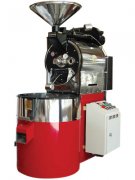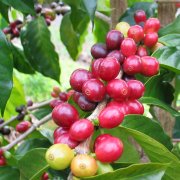Use chemical knowledge to help you analyze the coffee ingredients of individual coffee products.
Any coffee enthusiast who knows how to drink coffee knows that really high-quality coffee is not too bitter, but for most of us, most of the coffee we drink is bitter.
Fortunately, through the principles of chemistry, even laymen without professional training can make coffee of good quality! Just like adding salt to coffee can lighten the bitterness, science can help us better understand the nature of food and make the coffee in our cup tastier.
Why is coffee bitter?
It is strange that people still fail to figure out why coffee is bitter. It is true that caffeine is bitter, but because it tastes light, caffeine is not the real source of coffee bitterness. Scientists have found that coffee also contains two other bitter substances: chlorogenic acid lactone and phenyllindane. The former is abundant in light and moderate roasted coffee, while the latter is higher in deep roasted coffee. In contrast, phenyllindane is more intense, so the bitterness of deep roasted coffee is more distinct and exciting.
Can adding salt to the coffee really neutralize the bitter taste?
It has been said that adding salt to coffee can neutralize bitterness, which sounds ridiculous, but it has been proved to be effective by science. In 1997, scientists tried to put salt into a bitter chemical solution and compared the bitterness of the solution. It was found that although the concentration of bitter elements in chemical solvents did not change, the chemical solution with salt did not taste so bitter.
The ratio of coffee to water
Adding salt to coffee can only be remedied after it is lost. To really solve the problem that coffee is too bitter, we must go back to its roots. From a chemical point of view, extraction is the real source of coffee flavor. The process of extraction is so sophisticated that only by grasping it correctly can the taste of coffee become better. Among them, the first thing we need to consider is the ratio of coffee to water. In general, the ideal gouache ratio is: 60 grams of coffee / 1 liter of water, equivalent to 1 gram of coffee powder / 16 milliliters of water, or 7 grams of coffee powder / each cup of espresso.
The ratio of coffee to water is extremely important, because the more coffee, the more bitter elements are extracted. Similarly, if the water is in contact with the coffee for too long, the content of bitter elements in the coffee will increase, while if there is too much water, the coffee will be too light and thin.
Brewing time is the second problem we need to consider. We can divide the extraction process of coffee into three steps. First, the acids in coffee, that is, chemical components with fruit aroma, will be extracted first. Then comes the earthy and caramel-flavored substances, and finally the bitter elements in the coffee. Therefore, if the brewing time is very short, the content of the first kind of fruit-flavored substances in the coffee will be higher; conversely, if the brewing time is long, the content of bitter elements in the coffee will increase, accompanied by astringency.
The perfect extraction should be between the two. Of course, the ideal extraction time of different brewing methods is different. For espresso, the contact time between coffee and water should be between 20-30 seconds, while for drip coffee, the brewing time should be between 2-4 minutes.
Temperature and bitterness
Water temperature can also affect the bitterness of coffee. The ideal water temperature for brewing coffee should be between 91 and 96 ℃. If the temperature is too high, the coffee will be charred and the astringency will be stronger; if the temperature is too low, the extraction of the coffee will not be enough. Of course, there are also cases where cold brewing coffee is extracted with extremely cold water, so the bitterness of the coffee is very mild and soft, but correspondingly, this brewing method takes a very long time.
The type and degree of grinding of coffee
Even with superb brewing skills, if the quality of the coffee itself is poor, the taste of the coffee is not much better. Generally speaking, there are two kinds of coffee: Arabica coffee and Robusta coffee. Among them, Arabica coffee is of better quality and taste. Robusta coffee contains more phenols, pyrrole, sulfur and other substances, so the taste of coffee is more astringent and rough.
In addition, the degree of coffee grinding will also affect the bitterness of coffee. If the coffee powder is too coarse, the coffee will not be extracted enough, resulting in the coffee taste too light; if too fine, the extraction of soluble substances in the coffee is too high, the coffee taste will be more bitter. In order to make the perfect coffee, you must find the best balance between the two.
Milk, sugar and coffee
If there's nothing you can do, you can fix it with milk and sugar. Milk not only masks the bitterness of coffee, lactose also increases the sweetness of coffee, sugar clots caffeine molecules, and its own sweetness makes coffee less bitter.
Well, now we understand that it's not easy to make the perfect coffee. But sometimes we don't drink coffee to taste its mellow, especially when we get out of bed at 6: 00 in the morning-believe me, as a teacher, I have a deep feeling. At this time, I care more about whether there is enough caffeine than whether the bitter taste of coffee is too strong. Anyway, with the help of chemical knowledge, I believe that your coffee every morning will become both refreshing and delicious!

Important Notice :
前街咖啡 FrontStreet Coffee has moved to new addredd:
FrontStreet Coffee Address: 315,Donghua East Road,GuangZhou
Tel:020 38364473
- Prev

Can you roast coffee beans yourself? Home baking
How the walls of your own roaster cafe are built, how the equipment is installed, how the long-delayed production license is obtained. And if all goes well, the next step is to think about hiring people. In fact, the human factor is one of the more important factors than the first three. For a home roasting cafe, the transfer of personnel determines its future operation and revenue.
- Next

Bakers must know baking knowledge.
Equilibrium Point When the roaster is fully preheated and the internal temperature of the boiler is around 200 degrees, place the prepared green beans into the oven. At this time, the raw beans in the furnace will begin to undergo endothermic reactions, and the internal tissues of the raw beans will begin to undergo endothermic reactions, that is, the sound beans will begin to absorb heat and absorb the temperature in the furnace into their own bodies, so the temperature in the furnace will begin to slowly decrease. When the temperature inside the furnace is low, the temperature inside the furnace will begin to decrease.
Related
- Beginners will see the "Coffee pull flower" guide!
- What is the difference between ice blog purified milk and ordinary milk coffee?
- Why is the Philippines the largest producer of crops in Liberia?
- For coffee extraction, should the fine powder be retained?
- How does extracted espresso fill pressed powder? How much strength does it take to press the powder?
- How to make jasmine cold extract coffee? Is the jasmine + latte good?
- Will this little toy really make the coffee taste better? How does Lily Drip affect coffee extraction?
- Will the action of slapping the filter cup also affect coffee extraction?
- What's the difference between powder-to-water ratio and powder-to-liquid ratio?
- What is the Ethiopian local species? What does it have to do with Heirloom native species?

